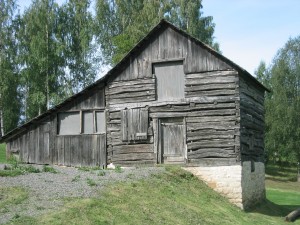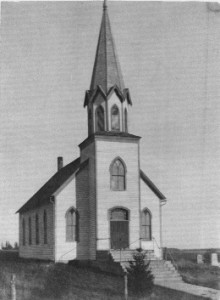 It’s hard to believe that Highland Township, in the northeast corner of Winneshiek County, Iowa, was once at the western edge of civilization. Here are excerpts from some early histories that show the difficulties as well as the promise of those who settled here. These early regional histories and many more are available for download.
It’s hard to believe that Highland Township, in the northeast corner of Winneshiek County, Iowa, was once at the western edge of civilization. Here are excerpts from some early histories that show the difficulties as well as the promise of those who settled here. These early regional histories and many more are available for download.
“A Wild and Unsettled Region”
From Sparks, Charles H., History of Winneshiek County: with biographical sketches of its eminent men, 1877
Previous to the year 1851, Highland Township was a wild and unsettled region, with the vast country lying west of it. But in that year, while the savages were still now and then to be seen in considerable numbers, three young men — Erick Davidson, Magne Nelson and Hagen Mastad — immigrated, in the spring, from Dane County, Wis., and some time in June, of that year, settled about one mile north of where Highlandville is now situated. For about one year these three young men held undisputed control of the country for miles around. In the spring of 1852 there was quite an influx of immigration, and among the most notable were the Arnesons, Knudt Bjorgo, M. John, Nels Nelson, Sr., with a family of three boys, viz : Andrew, Ole and Nels, Jr., who have played quite a conspicuous part in the history of Highland Township. In the same year Albert Stoneson made his appearance with a blooming young bride, and commenced housekeeping and selected his homestead a little north of the three that first settled here. He, with all the rest of them, had no means to speak of; but he went diligently to work, and soon made himself independent, and has long been one of the wealthiest farmers of this township. He is now surrounded by a large family of young men and women.
In the years following there were quite a number that came to Highland Township, among the most notable of whom was E. Berg, father of the late Hon. K. Berg and Rev. J. Berg. K. Berg had preceded his father to this country, and had made his home, before his father’s arrival here, in Dane County, Wis.
When Decorah enjoyed the palmy days of the United States Land Office, Highland Township suffered with the rest of the county in respect to her unoccupied lands. Every acre was gobbled up by speculators, and great was the struggle among the squatters who had not already a United States patent on their homestead. A great number lost their land, as they were not able to borrow money at the then ruling rate of interest, which was 40 percent. The immigration then ceased for quite a while, and was almost at a standstill till 1860, or the beginning of the War of the Rebellion. But in the meantime the pioneers of Highland had not been idle. Most of them had become well-to-do farmers, and many of them were already on the road to wealth, of whom I must not forget to mention Lars Olson, who came from Muskegon here in the year 1851 with only a few hundred dollars. He began to lend his money at 40 per cent, and in the short space of twenty years had amassed a fortune of almost $100,000, without any kind of speculation whatever. Olson died about three years ago, and his money is divided among his large family of ten boys and girls, who are scattered over the southern part of Minnesota.

Sacquitne barn, built in Highland Township, now at Emigration Museum in Hamar, Norway. The first school in Highland Township was on the Sacquitne farm east of Highlandville.
About the year 1856, a school district was organized, consisting of almost the whole township. At that time the township was not very thickly settled. In the spring of 1857 a small log school-house was erected, which has long since given place to a large and commodious frame building, with all the modern improvements. It was in this old log school-house that the late Prof. Berg taught his first English school, and where K. Bjorgo, Jr., learned his ABC’s. He is now a young minister of the Lutheran Synod, of marked ability, having few equals and no superiors among the younger ministers. Martha K. Bjorgo was the first child born in the township.
In 1857 a Lutheran congregation was organized in Pleasant and Highland Townships, and they, in conjunction with Spring Grove, Minn., called C. L. Clauson as their spiritual adviser. He served the two congregations for some time; but his labors became too arduous, and the congregations separated, about three years after their organization, Spring Grove retaining the minister, who only lived a few years longer, he being the first Lutheran minister that died in this country.
[htmlembed name=”HighlandPlat1905″]
Quick Update from 1882
From Alexander, W. E., History of Winneshiek and Allamakee Counties, Iowa, 1882
In 1860 … Highland divided from Pleasant [Township].
Highland is the northeastern township of the county. Its post-office, Highlandville, is in the southern part of the township.
Highland township had a population of 782 by the census of 1880. Highlandville has about 50 inhabitants. Bear Creek furnishes power to its flour mill, and it has a store and other business.
[htmlembed name=”HighlandPlat1915″]
“Such Were the Pioneer Days for the First Settlers”
From Bailey, Edwin C, Past and Present of Winneshiek County, Iowa: A record of settlement, organization, progress and achievement, Volume 1, 1913
In 1850 the county welcomed its first Norwegian settlers. During the years immediately following this settlement the central part of the county, and even well up into Highland township, received steady and increasing accessions of settlers from Norway. Today their descendants represent about half of the population of the county.
Before Highland township was organized it was at first a part of Pleasant township and the west part of the township was commonly called “Pleasant prairie.” In 1852 or 1853 (according to recollections) the first settlers began to come in and locate in the south part of the township. The first settlers were the Stoens, Brunsvold, Arnesons and Mikkel Solberg; and in the north and east part were located Peter Uldvikson, Paul Dagfinson, Bersie, Kjomme, Kroshus, Mikkel Walhus and some others. In the west part were Wennes, Halland, Luros, Svenung Bergan and Ole Johnson Svartebratten. The two latter soon sold out to Elihu Talbert and Thomas Painter. Shortly after that time the township was organized. It borders on the state line of Minnesota and contained only a little over thirty sections of land.
In those early days there was no mill nearer than Decorah and Freeport, about twenty miles distant. With ox teams it took one day to go and another to come back, besides waiting from one to three days at the mill to get the grist. Some time later a mill was built on the Canoe river, known as Springwater, about ten miles off; and still later a mill was built inside the township at what is now known as Highlandville. This mill was discontinued because the water power failed. The mill was owned by one Peter Olson, who died a short time ago. From the beginning and up in 1860, nearly all parts of the township were more or less settled. In the winter of 1857 there was a big snow on the ground from two to three feet deep. A rain on the top of that and cold weather made an ice crust about one inch thick, so that no teams could move without first crushing down the ice. Some people had their hay stacked out on the prairie where it was mowed, and the writer of these lines has seen men on snow shoes with a hand sled drawing their hay home, a distance of about two miles, on the top of that ice. Such were the pioneer days for the first settlers.
The first school in the township was taught by Addison Hoag in a private house belonging to N. N. Kjomme, but soon after a log schoolhouse was built on the four corners near the center of the township. The first teacher in that schoolhouse was Samuel Aikins, a well known resident from over the line in Minnesota. Another schoolhouse was shortly after built in the west part of the township, on section 7, by private subscriptions, and that schoolhouse was afterwards moved one mile south.
At the present time the township is well provided with schools, having six on a territory of twenty-six and one-half sections of land. A small part of the township belongs to Pleasant township for school matters.
During the War of the Rebellion the township furnished several soldiers as volunteers and some substitutes who were paid a liberal bounty by the residents to save the township from drafting.
There is no record old enough to show who were the first township officers but among some of the oldest officers were K. Tobiason, John Anderson Kroshus, Nels N. Kjomme, Aad Nordheim, F. M. Gumning, Amnon Arneson and some others.
There is only one town inside the township, the platted village of Highlandville. It has a population of a little over one hundred. It is a town without any railroad, and yet it is doing a lively business as a country town. Besides a post office there are three general stores, one blacksmith shop, one creamery, one doctor, two or three establishments for the sale of farm machinery, besides mechanics, and last, but not least, a new modern schoolhouse, built lately at a cost of about twenty-five hundred dollars. The building looks well and is an improvement to the town.
There is one Lutheran church inside the township and two creameries doing good business. The farmers of the township have made good progress and as a rule are well to do. Highland township had 808 residents in 1890; 829 in 1900, and 785 in 1910.
Also on the Web
- Highland Lutheran Church also offers a wonderful look at the early history of its congregation.
- Paul Cutting of Decorah has visited a few of the relics of Highland Township and has some nice photos of the old houses occupied by these settlers.
- Decorah Genealogy Association provides E.J. Weigle’s account of early Highland Township history.




4 Responses to Highland Township’s Early History